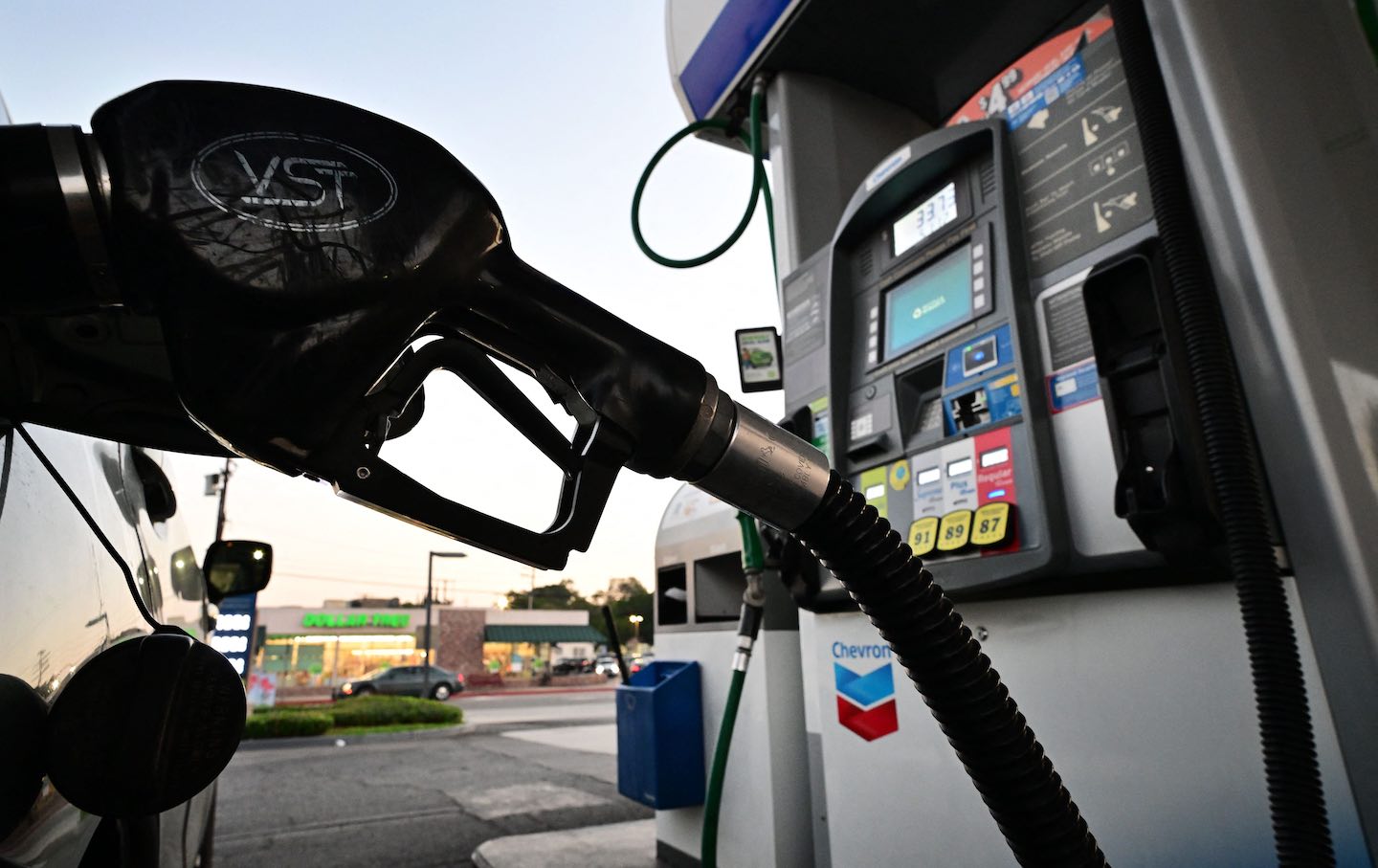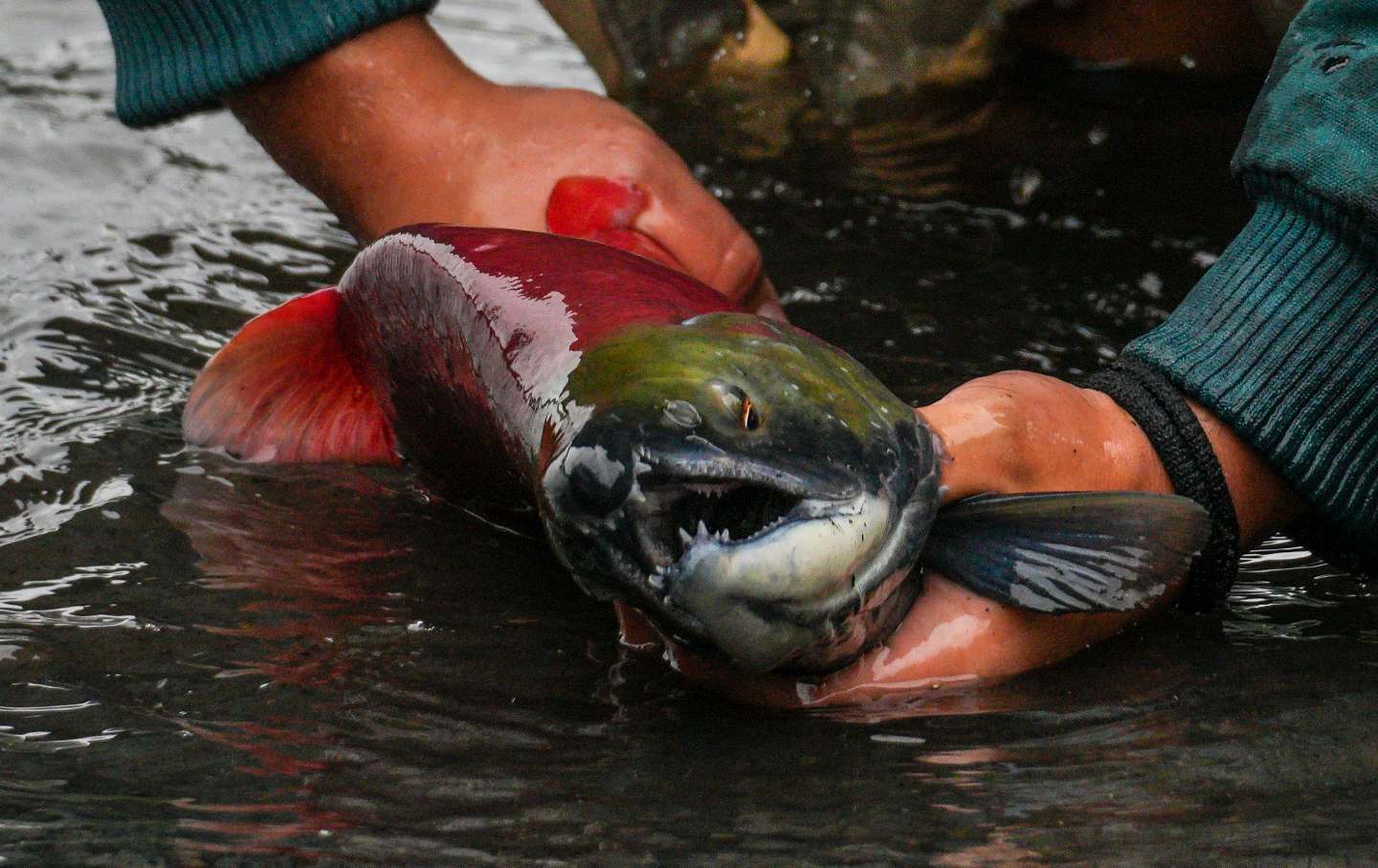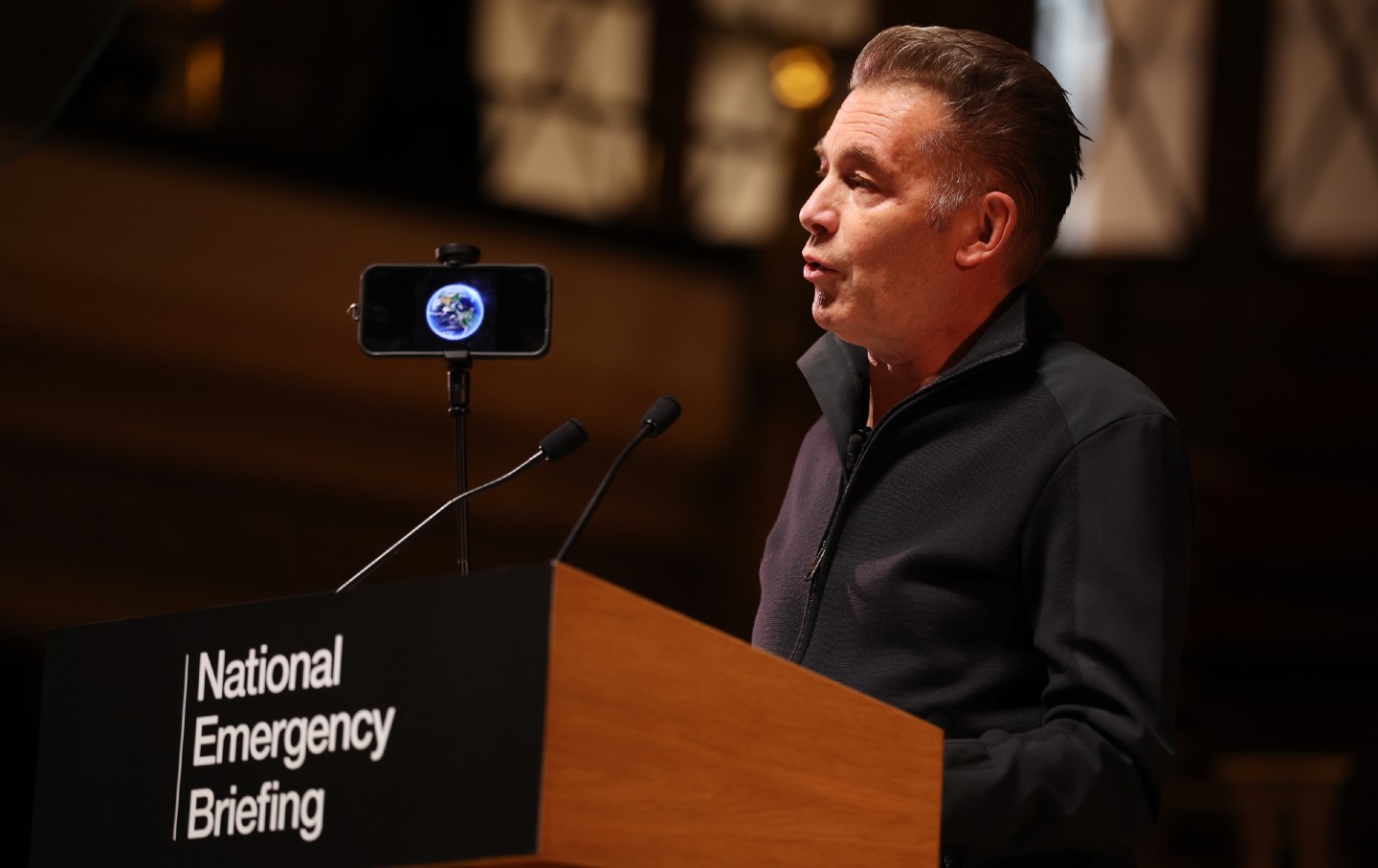Lithium Isn’t a Climate Change Quick Fix
Why the “White Gold Rush” will not save this planet.

This article originally appeared at TomDispatch.com. To stay on top of important articles like these, sign up to receive the latest updates from TomDispatch.com.
With his perfect tan and slicked-back hair, California Governor Gavin Newsom stood at a podium at Sacramento’s Cal Expo in late September 2020 and announced an executive order requiring all new passenger vehicles sold in the state to be zero-emissions by 2035. With the global Covid pandemic then at its height, Newsom was struggling to inject a bit of hope into the future, emphasizing that his order would prove a crucial step in the fight against climate change while serving as a major boon to the state’s economy. Later approved by the California Air Resources Board, his order is now being reviewed by the Environmental Protection Agency. For his part, President Biden has moved to tighten regulations on tailpipe exhaust, a not-so-subtle way of pushing car manufacturers to go electric.
As Newsom said shortly before signing his order on the hood of a bright red electric Ford Mustang Mach-E:
“Our cars shouldn’t make wildfires worse and create more days filled with smoky air. Cars shouldn’t melt glaciers or raise sea levels threatening our cherished beaches and coastlines.… This is the next big global industry, and California wants to dominate it. And that’s in detoxifying and decarbonizing our transportation fleets…. And so today, California is making a big, bold move in that direction.”
One stereotype about Californians is true: We do drive a lot, which also means we buy a lot of new cars. California is, in fact, the top seller of new vehicles in the United States, with more than 1.78 million cars and trucks rolling off its lots in 2023. In total, significantly more than 14 million vehicles are registered in the state, nearly the same number as in Florida and Texas combined. So Newsom is undoubtedly right that ridding our roads of combustion engines will significantly reduce the state’s climate toll. After all, California’s transportation sector alone is responsible for more than 40% of its greenhouse gas emissions.
On the surface, Newsom’s executive order appears all too necessary, indeed vital, if the use of fossil fuels is to one day be eliminated and climate change mitigated. California is also home to more than 50 electric vehicle manufacturers, and car companies that don’t get on board will soon find themselves “on the wrong side of history,” as Newsom warned. “And they’ll have to recover economically, not just recover in terms of being able to look their kids and grandkids in the eyes.”
Underpinning the governor’s ambitious goal of an all-electric future is another reality. While we may change the kinds of cars we drive, we won’t change our lifestyles to fit a climate-challenged future. Millions upon millions of new zero-emission vehicles will be required and to create them, we’ll need staggering amounts of resources that are still lodged below the earth’s crust. On average, a single battery in a small electric car today contains eight kilograms (17.5 pounds) of lithium, or “white gold.” To put that in perspective, if Californians continue to purchase vehicles at the same pace as in 2023, the amount of lithium required will exceed 113 million kilograms (249 million pounds) annually going forward.
That’s a mountain of lithium and an awful lot of mining will need to be done to make the governor’s plan a reality. And mind you, those figures are lowball estimates—a Tesla Model S battery needs 62.6 kilograms of lithium, for instance—and they don’t address the additional mining electric vehicles will demand to produce considerable amounts of cobalt (14 kilograms), manganese (20 kilograms), and copper (upwards of 80 kilograms) per car. Newsom is correct: Ridding California’s sprawling freeways of gas-guzzlers is a necessity and will also be highly profitable, especially for the extraction industry. Nevertheless, it will come with significant cultural and environmental costs that must be accounted for.
A Lithium Bonanza
It’s a scorching hot afternoon in the middle of August and I’m heading west on State Route 293 through Humboldt County in northern Nevada. I’m just a few miles south of where the Thacker Pass lithium mine operation has broken ground. The terrain, managed by the Bureau of Land Management (BLM), part of the Department of the Interior, is sparse and vast. The sky is cloudless, the soil bone-dry. I pass a coyote scampering through the sagebrush. In the distance, the Montana Mountains rise above the flats, casting a long shadow. While dramatically serene, this landscape, located in the middle of the McDermitt Caldera, along with its almost boundless lithium deposits, holds a hauntingly shameful history.
On September 12, 1865, American soldiers carried out a massacre of the Numu (Northern Paiute) near Thacker Pass. Natives call the area “Peehee mu’huh,” or “rotten moon,” to honor the victims. As the story goes, Indigenous Numu were being hunted by the 1st Nevada Cavalry and decided to hide out near Thacker Pass. Dozens of them, including women and children, were eventually found and slaughtered.
An article in the September 30, 1865, edition of The Owyhee Avalanche detailed the carnage. “A charge was ordered and each officer and man went for scalps, and fought the scattering devils over several miles of ground for three hours, in which time all were killed that could be found.” In all, 31 bodies were located, but “more must have been kill[ed] and died from their wounds, as a strict search was not made and the extent of the battlefield so great.”
Today, descendants of the massacre victims are still fighting to designate Thacker Pass and the surrounding area as a memorial site in the National Register of Historic Places. By doing so, they hope the bulldozers will be forced to shut off their engines and lithium mining will cease. In 2021, federal judge Miranda Du rejected their plea, noting that the evidence they presented was “too speculative” to stop the company, Lithium Americas, from prospecting there. In the years since then, the protesters have encountered significant setbacks but have refused to quit.
“All the people here on the reservation were not consulted when this mine was approved,” says Dorece Sam, a descendant of Ox Sam, one of only three survivors of the bloody 1865 massacre at Thacker Pass. Along with six others, he’s currently being sued by Lithium Nevada Corp. (a subsidiary of Lithium Americas) for protesting the mine. “Myself as an Ox Sam descendant, it means a lot to me to know and watch…as the grounds become more and more desecrated. It’s hard to see and hard to watch.”
Lithium Americas pitched its plan to the BLM in 2019 and broke ground at Thacker Pass in March 2023. Native tribes and environmental groups have argued in various court proceedings that the BLM rushed its environmental review without properly consulting the tribes in the approval process. The Ninth Circuit Court of Appeals shot down their best-chance lawsuit in July.
In a previous 2023 ruling, a lower court stated that the BLM had indeed violated federal law by approving the mine since Lithium Americas hadn’t demonstrated its rights to the 1,300 acres it would, in the future, bury in waste rock from its mining. Despite that acknowledgment, presiding Judge Du failed to revoke the company’s permits.
“Our hearts are heavy hearing the decision that Judge Du did not revoke the permits for the Thacker Pass Lithium Mine. Indigenous people’s sacred sites should not be at the expense of the climate crisis the U.S. faces. Destroying Peehee Mu’huh is like cultural genocide,” said the People of Red Mountain, Indigenous Land and Culture protectors, following Du’s decision.
The “Right” to Mine
While the courts ruled in favor of the Bureau of Land Management’s audit, few are disputing that the Thacker project will have a deleterious impact on the region. For one thing, when the mine is up and running, it will need an exorbitant amount of groundwater for its operations. An estimated 1.7 billion gallons sucked from the Quinn River Valley, an already overburdened aquifer, will have to be pumped into the mine annually. Opponents of the project also note that chemicals used in the lithium extraction process could leach into groundwater supplies, polluting nearby creeks, home to the already threatened Lahontan cutthroat trout. The Thacker basin is also a vibrant wildlife corridor for pronghorn antelope, mule deer, and home to the single largest sage-grouse population in Nevada.
In total, the Thacker Pass mine, the largest known lithium deposit in this country, could one day eat up more than 17,000 acres of public lands, more than half the size of San Francisco. It’s set to be the largest lithium mine in the country, churning out as many as 40,000 metric tons annually, enough to power 800,000 electric vehicles. Inevitably, Thacker will make Lithium Americas’ shareholders very rich, bringing them an estimated nearly $4 billion once all the recoverable lithium is extracted. However, that projection, from 2021, was based on the price of lithium when it sold for an average of $12,600 per ton. By 2023, a ton of lithium was selling for around $46,000.
Promising that the mine will power its all-electric-vehicle future, General Motors now holds exclusive rights to the lithium the mine will extract and has invested $650 million in it. President Biden’s Department of Energy is also all in, loaning $2.26 billion to Lithium Americas to jump-start the project.
Popular
“swipe left below to view more authors”Swipe →The Thacker Pass lithium mine is but one of many examples of the way Native lands have been and continue to be exploited. The 1872 Mining Act and the Dawes Act of 1887 have long permitted the federal government to stake claims to tribal lands without their consent.
“The Mining Law allows United States citizens and firms to explore for minerals and establish rights to federal lands without authorization from any government agency. This provision, known as self-initiation or free access, is the cornerstone of the Mining Law,” reads a report on that law by Lawrence University economics professor David Gerard. “If a site contains a deposit that can be profitably marketed, claimants enjoy the ‘right to mine,’ regardless of any alternative use, potential use, or non-use value of the land.”
The Dawes Act went even further, allowing the federal government to divide tribal lands into smaller parcels that could be sold off to individual buyers, part of a sinister scheme to delegitimize Native sovereignty on lands that had been stolen from them in the first place.
“It served the larger purpose because the larger purpose was twofold: to make us more like white people or destroy us and get large amounts of land out of Native control and into the hands of individual, non-Native citizens,” says Kelli Mosteller, director of the Citizen Potawatomi Nation Cultural Heritage Center. “The Dawes Act solidified once again the distrust that has settled in about dealing with the government. Every time the government comes in and asks for something, there is always that ulterior motive.”
The mine at Thacker Pass, which will end up slicing a gash in the earth a mile wide and 2.3 miles long, is just the latest example of an ugly legacy of ravaging former Native lands for profit.
“Are we still in a situation where the rich get rich and the tribes get poorer because they don’t get a dime off of the mining that happens within their original lands? That’s hard to swallow,” says Arlan Melendez, chair of the Reno-Sparks Indian Colony.
Going Back to California
A significant underground lithium deposit has also been discovered near the south end of California’s dilapidated and toxic Salton Sea, once a playground for Hollywood’s elite. While it’s not nearly as large as the one at Thacker Pass, estimates put the extractable deposits of lithium at upwards of 18 million metric tons, enough to eventually fill 380 million electric vehicle batteries.
Of course, digging out all that smoldering “white gold” will come at a cost there, too, not just economically but environmentally. What those effects will be, exactly, has yet to be revealed. Even so, Governor Newsom made his way to the Imperial Valley and the Salton Sea, a region he hopes might be transformed into a hub for electric battery production and that he’s smugly branded “Lithium Valley.”
“California is poised to become the world’s largest source of batteries, and it couldn’t come at a more crucial moment in our efforts to move away from fossil fuels,” said Newsom. “The future happens here first—and Lithium Valley is fast-tracking the world’s clean energy future.”
How clean that future will be remains to be seen. Here’s one thing to consider, though: No matter how this all turns out, Newsom’s electrified vision of the future doesn’t mean fewer vehicles on the road or a reduction in America’s energy consumption. The California governor isn’t about to challenge the tenets of global capitalism that, with a significant helping hand from global warming, are already driving us toward the brink of ecological collapse. In all too many ways, at least as now planned, more mining, even of lithium, will mean not a new world but an all-too-grim continuation of the status quo. The key difference is that this time around, it will come with a “green” stamp of approval.
In other words, despite the horrors of climate change, the present approach to fixing it, whether by mining for lithium in the Salton Sea or dredging up the spirits of Thacker Pass, is deeply problematic. As long as every single thing on this planet remains a commodity to be exploited for profit, whether labor or natural resources, humanity will remain in crisis. If we proceed as planned down this violent and bumpy road ahead, we may (or may not) save our imperiled climate, but one thing is certain: Our little planet will be left in ruins, while the wealthy speed off in their Teslas.
Disobey authoritarians, support The Nation
Over the past year you’ve read Nation writers like Elie Mystal, Kaveh Akbar, John Nichols, Joan Walsh, Bryce Covert, Dave Zirin, Jeet Heer, Michael T. Klare, Katha Pollitt, Amy Littlefield, Gregg Gonsalves, and Sasha Abramsky take on the Trump family’s corruption, set the record straight about Robert F. Kennedy Jr.’s catastrophic Make America Healthy Again movement, survey the fallout and human cost of the DOGE wrecking ball, anticipate the Supreme Court’s dangerous antidemocratic rulings, and amplify successful tactics of resistance on the streets and in Congress.
We publish these stories because when members of our communities are being abducted, household debt is climbing, and AI data centers are causing water and electricity shortages, we have a duty as journalists to do all we can to inform the public.
In 2026, our aim is to do more than ever before—but we need your support to make that happen.
Through December 31, a generous donor will match all donations up to $75,000. That means that your contribution will be doubled, dollar for dollar. If we hit the full match, we’ll be starting 2026 with $150,000 to invest in the stories that impact real people’s lives—the kinds of stories that billionaire-owned, corporate-backed outlets aren’t covering.
With your support, our team will publish major stories that the president and his allies won’t want you to read. We’ll cover the emerging military-tech industrial complex and matters of war, peace, and surveillance, as well as the affordability crisis, hunger, housing, healthcare, the environment, attacks on reproductive rights, and much more. At the same time, we’ll imagine alternatives to Trumpian rule and uplift efforts to create a better world, here and now.
While your gift has twice the impact, I’m asking you to support The Nation with a donation today. You’ll empower the journalists, editors, and fact-checkers best equipped to hold this authoritarian administration to account.
I hope you won’t miss this moment—donate to The Nation today.
Onward,
Katrina vanden Heuvel
Editor and publisher, The Nation
More from The Nation

The Fight for the Last Wild Salmon The Fight for the Last Wild Salmon
In Alaska, the last stronghold for wild salmon, Native tribes and conservationists are working to save the fish from both climate change and decades of corporate greed.

What Your Cheap Clothes Cost the Planet What Your Cheap Clothes Cost the Planet
A global supply chain built for speed is leaving behind waste, toxins, and a trail of environmental wreckage.

The UK’s Climate National Emergency Briefing Should Be a Wake-Up Call to Everyone The UK’s Climate National Emergency Briefing Should Be a Wake-Up Call to Everyone
The briefing was a rare coordinated effort to make sure the media reflects the science: Humanity’s planetary house is on fire, but we have the tools to put that fire out.

AI Will Only Intensify Climate Change. The Tech Moguls Don’t Care. AI Will Only Intensify Climate Change. The Tech Moguls Don’t Care.
The AI phenomenon may functionally print money for tech billionaires, at least for the time being, but it comes with a gargantuan environmental cost.

Backsliding in Belém Backsliding in Belém
Petrostates at COP30 quash fossil fuel and deforestation phaseouts.

Wake Up and Smell the Oil. Your Nation’s Military Is Hiding Its Pollution From You. Wake Up and Smell the Oil. Your Nation’s Military Is Hiding Its Pollution From You.
A fact all but ignored at COP30.


